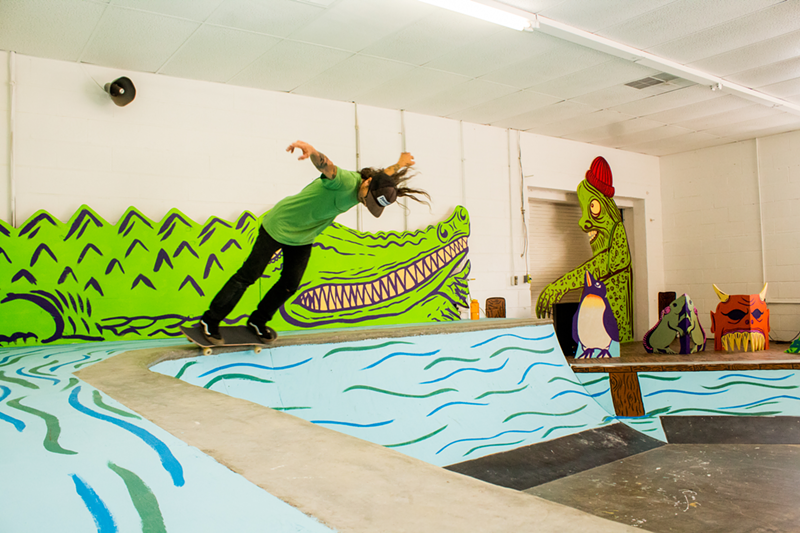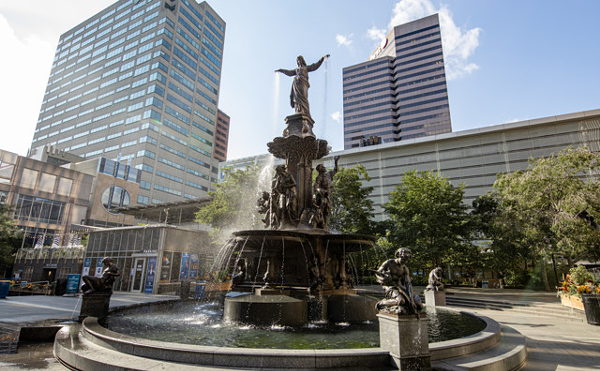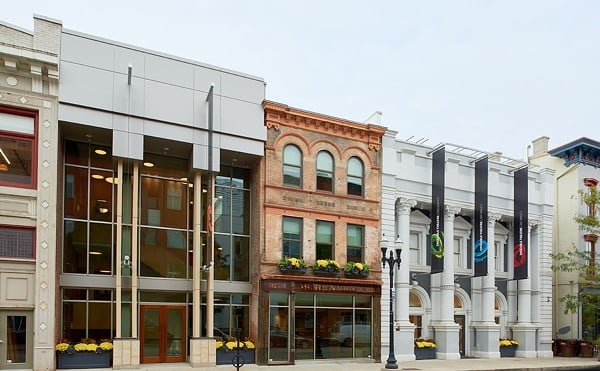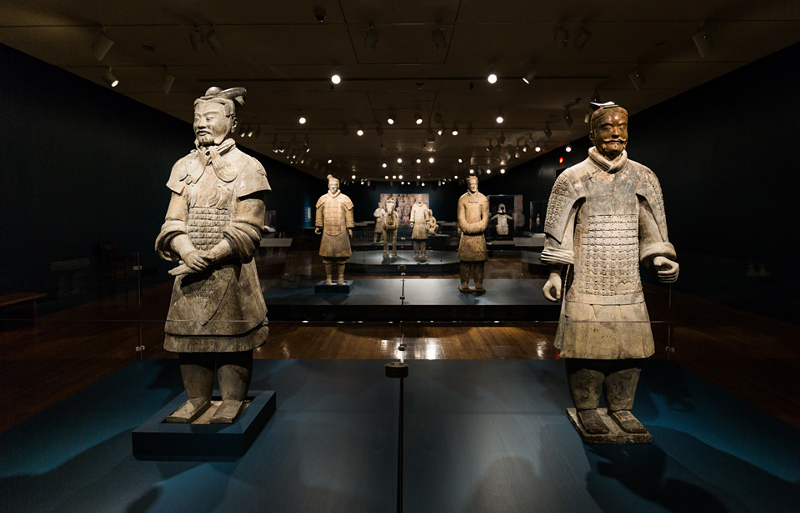
In Cincinnati, 2018 very well could be dubbed the year that art crept outside the borders of a frame and into works upon we swung, skated and even ate from. It was a year marked by far-reaching regional festivals (we’re looking at you, FotoFocus), anniversaries and record-breaking shows.
The Cincinnati Art Museum’s Terracotta Army: Legacy of the First Emperor of China fits into the latter category. From April 20-Aug. 12, the museum saw nearly 140,000 visitors; 91,628 of those came specifically for this ticketed exhibition. Those numbers mark Terracotta Army as the highest-attended exhibit to date since 1982’s Treasures From the Tower of London. Ten life-size terracotta warrior figures from China’s Pre-Qin era (770-221 BC) and throughout the Qin dynasty filled the space, alongside leather armor, gold works, ceramics, jade ornaments and more.
After its closure, Fabric of India sprawled through the CAM’s Western & Southern Galleries, washing the space in colorful, intricately spun cloth and textiles. Despite its strong impact on India (and, really, the world), the show is the first major exhibition focused specifically on handmade Indian fabrics. Its stint in Cincy marks the U.S. debut for the show, which originated at London’s Victoria & Albert Museum. (The exhibit closes Jan. 6.)
This year’s FotoFocus Biennial had ties to more than 90 exhibits and events across Greater Cincinnati, Dayton and Columbus. In its fourth iteration, FotoFocus looked toward its “Open Archive” theme to showcase historical and modern photography alike. With most exhibits and programming unfolding in October, the month was packed. Big names that showed up to participate included Miranda July, whose film project Joanie 4 Jackie was showcased at the Mini Microcinema; Life: Gillian Wearing came to CAM, where the exhibit’s namesake — a Turner Prize winner and conceptual photographer and video artist — explored a multitude of selves via masks, staging and more.

Wearing recreated portraits of other artists like Marcel Duchamp, Albrecht Dürer and Georgia O’Keeffe — whom she considers her “spiritual family” — using herself as a stand in. Peel back the mask: Underneath the initial layer was Wearing, making us question the act of expression.
Within the frame of a retro TV, we also saw her dance uninhibited as mall-goers rushed past in consumed blurs. Perhaps the crux of this exhibit was Wearing, Gillian, a five-minute video that featured a wide range of people wearing a version of the artist’s face, applied via an artificial filter (not so different than the ones found on Snapchat or other social media platforms). It begged the question: Can the real Gillian stand up?
Other FotoFocus highlights included the Taft Museum of Art’s From Paris to New York: Photographs by Berenice Abbott and Eugène Atget. At the time, CityBeat freelancer Kathy Schwartz wrote that it was like “viewing an arthouse movie in which an intriguing storyline unfolds with moody cinematography.” Locals got involved, too. Take Michael Wilson, whose work was displayed at the Public Library of Cincinnati and Hamilton County’s Main Branch. In They Knew Not My Name, and I Knew Not Their Faces, Wilson captured the faces of strangers he encountered in Cincinnati. (On view through Dec. 31.)Camp Washington’s Wave Pool gallery similarly presented work that engaged the surrounding neighborhood for their slice, dubbed Social Medium.
I’d be remiss if I didn’t mention the Contemporary Arts Center, which dedicated every floor to FotoFocus in 2018. No Two Alike: Karl Blossfeldt, Francis Bruguière and Thomas Ruff placed 1920s modernist images taken by Blossfeldt and Bruguière with abstractions by the contemporary artist Ruff. You can see that show through Jan. 13.
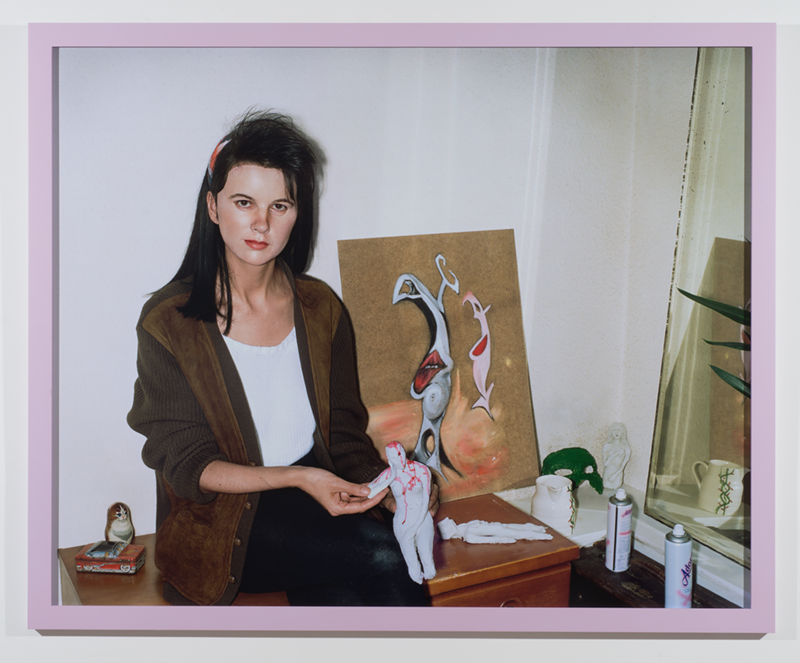
Lebanese artist Akram Zaatari was also featured via The Fold — Space, time and the image. A co-founder of the Arab Image Foundation, he works to preserve photographs from the Middle East, North Africa and the Arab diaspora, stretching back from the 19th century to today. The exhibit, on view through Feb. 10, explores that very collection, displaying black-and-white images along a stretch of wall.
Swedish artist and painter Mamma Andersson’s Memory Banks drew us in with dreamy, folk-infused work that captures the surreal in everyday moments. It’s also on view through Feb. 10.
Lastly, photographs from Raquel André’s A Collection of Lovers occupied the lower floor. Her work also delved into encounters with strangers (167 to be exact, as of August 2018.)
While FotoFocus dominated the fall, presenting a daunting amount of material, lens-based exhibits still shined this year outside of that. Ansel Adams — hailed as one of America’s most important 20th-century nature photographers — got a share of the spotlight this summer at the Taft Museum of Art. Ansel Adams: A Photographer’s Evolution was a striking, stunning show. Adams’ stark black-and-white photographs lined the walls, capturing American landscapes (and, often, national parks.) Viewers could see the shifts in aesthetic change as years passed and technology advanced. (Adams was born in 1902 and died in 1984.)
Overlapping with Adams’ exhibit, Pittsburgh-based Vanessa German was the Taft’s Robert S. Duncanson Artist-in-Residence. Her show, running with freedom, featured powerful figures that depicted black female bodies. Each was crafted with both handmade and found objects. (German collected materials from abandoned lots, flea markets, the trash, etc.) One sculpture — titled “I Am Reaching For a New Day” — wore bright yellow Converse shoes. With a body made of patchwork quilts, she held a bullhorn, abloom with a bouquet in one hand. Each figure presented was vibrant; some were made up of power cords, others had bluebirds perched in their chests.
But art didn’t only find itself in museum and gallery corridors. SkateAble vs Non — a pop-up project backed by a People’s Liberty grant and housed in the nonprofit’s Camp Washington gallery storefront — was an indoor skatepark that doubled as an art installation. Funky cartoons — alligators, cool cats, doggos, scrunched up faces, dinosaurs, jagged skulls — splayed out on quarter-pipes, ramps and spines.
The “non” part of the project came in the form of the most chill backyard of 2018, complete with a bat-shaped basketball backboard, wavy pastel pink benches, a skeeball ramp shaped like Fiona the Hippo and a literally rocking yellow wooden cow.
Like SkateAble, Mark de Jong’s Swing House is based in Camp Washington. And when guests stroll in, they become a part of the art. The cerulean exterior of de Jong’s whole-home project blends neatly into the surrounding urban block. Inside the three-story house, a wooden swing is suspended from the ceiling by 30 feet of rope attached to a metal rod. And yes: You can use it.
Natural light leaks in; the space is completely open — de Jong removed the upper floors and walls entirely. A bed, dresser, lamps, kitchen space and the swing all flow into each other. Exposed brick walls greet onlookers, covered in a spotty patchwork of plaster and paint from former rooms. Smaller art pieces related to Swing House are displayed in a basement gallery.
While some may have explored the space during one of its “open house” touring days, other Cincinnatians may have experienced it through the CAC’s exhibit of the same name, open April 20-Sept. 30 of this year. Pieces, photographs and more related to the house — and his other projects — were displayed. One of those was “Stair House Ephemera,” a grid made up of 338 circles extracted from Stair House, the namesake’s neighboring home.
“Dead Souls Cake” also made use of childlike whimsy, but with heightened volume. Stuffed animals made up the 11-foot birthday-cake-shaped sculpture, topped with towering “candles.” I saw it housed at Felsenhaus242, a gallery located on West McMicken Avenue in the West End during a pop-up thrift shop and art show. But the fun piece made its debut at The Carnegie’s The Art of Food annual show and party. Dreamt up by Bill Ross of Northside’s Thunder-Sky, Inc., the giant faux pastry really evokes the kid inside of us all. Shimmering streamer-like strands form a makeshift door, where inside a TV juxaposes Night of the Living Dead clips with scenes from 1960s birthday parties.
In September, CAC-goers could snag food in the museum’s lobby via a street food cart. But the accompanying exhibit War Gastronomy ran deeper than grab-and-go. In partnership with San Francisco’s Collective Action Studio, the mobile cart doubled as a way to connect the community via the act of storytelling. Also in cahoots was Wave Pool gallery’s The Welcome Project — a nonprofit established to help refugee and immigrant women through community building and various classes. (The recipes served at the cart were provided by the women.) Aside from the cart itself, guests could also take a seat at the 10-foot-long communal coffee table or watch a visual archive of stories shared at past events.
But before we completely shed 2018, I propose a toast to one of the Queen City’s greats; this year, Art Academy of Cincinnati celebrated its 150th year as an academic institution. Among events and showcases, a book was also published: Art Academy 150: Make Art. Make a Difference, which chronicles a history that includes alumni like Frank Duveneck, Julian Stanczak and Charley and Edie Harper. Now, where’s the champagne?
A Look Ahead to 2019
Inching toward 2019, the 21c Museum Hotel’s current exhibit won’t close until July — though it has been on display since September of this year. The works presented within Truth or Dare: A Reality Show delve into shaky realities, often steeped in a socio-political commentary. Upon entering the hotel, guests are greeted by a multi-colored wallpaper covered with geometric shapes made by artist Claudia Hart. With a cellphone app called Layar, those designs morph into internet-coded art — as if you fell asleep mid-scroll and experienced a Twitter fever dream complete with emojis. Other works are steeped in similar conflicting layers. Guests also encounter lines pulled from Hamlet (just not the ones you’d expect), a fake puddle complete with a convincing dripping soundtrack, a warped and mind-tripping selfie installation, a steel column that’s actually wood slicked in oil and more.
Cincinnatians can also look forward to the return of BLINK, slated for Oct.10-13, 2019 (the inaugural event took place Oct. 12-15, 2017). The popular light and art festival amassed one million visitors in its run last year. Produced by creative organization Brave Berlin, the free four-day fest stretched from The Banks to the edges of Over-the-Rhine. Next year, Covington will see its own share of light installations, too. Though there’s still much planning ahead of the team, BLINK will likely snake through to the intersection of Seventh and Madison streets in the Cov.
The City of Light — aka Paris, France — will make a temporary home at the CAM come March 1. (It will leave May 12.) The exhibit — dubbed Paris 1900: City of Entertainment — will explore Paris as it encountered the turn of the 20th century.

